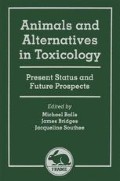Abstract
The recognition that cancer accounts for almost one-third of all deaths in the United Kingdom provides the driving force to identify its causes and thus prevent this disease with its vast social, human and economic costs (1). Whilst the disease has been recognised for many centuries, we are no nearer to making significant inroads into improving a patient’s prognosis for the majority of solid tumours, so cancer prevention should be a major goal.
Preview
Unable to display preview. Download preview PDF.
REFERENCES
Doll, R. (1978). An epidemiological perspective of the biology of cancer. Cancer Research 38, 3573–3583.
Stanbridge, E.J. (1990). Identifying tumor suppressor genes in human colorectal cancer. Nature, London 247, 12–13.
Croce, C.M. (1986). Chromosome translocations and human cancer. Cancer Research 46, 6019–6023.
Salsburg, D. (1989). Does everything ‘cause’ cancer: an alternative interpretation of the ‘carcinogenesis’ bioassay. Fundamental and Applied Toxicology 13, 351–358.
Horton, L. (1989). Commentary: the enduring animal issue. Journal of the National Cancer Institute 81, 736–743.
Garner, R.C. (1990). Interactions of carcinogens with nucleic acids. In Biochemistry of Chemical Carcinogenesis (ed. R.C. Garner & J. Hradec), pp. 89–97. New York: Plenum Press.
Miller, E.C. & Miller, J. A. (1947) The presence and significance of bound aminoazo dyes in the livers of rats fed p-dimethylaminoazobenzene. Cancer Research 7, 468–480.
Miller, J. A. (1970) Carcinogenesis by chemicals: an overview. Cancer Research 30, 559–576.
Gonzalez, F.J. (1989) The molecular biology of cytochrome P450s. Pharmacological Reviews 40, 243–288.
Ames, B.N., Gurney, E.G., Miller, J.A. & Bartsch, H. (1972) Carcinogens as frameshift mutagens: metabolites and derivatives of 2-acetylaminofluorene and other aromatic amine carcinogens. Proceedings of the National Academy of Sciences of the United States of America 69, 3128–3132.
Garner, R.C, Miller, E.C. & Miller, J.A. (1972). Liver microsomal metabolism of aflatoxin B1 to a reactive derivative toxic to S.typhimurium TA1530. Cancer Research 32, 2058–2066.
Mailing, H.V. (1971). Dimethylnitrosamine: formation of mutagenic compounds by interaction with mouse liver microsomes. Mutation Research 13, 425–429.
Anon. (1989). Department of Health Report on Health and Social Subjects. No. 35: Guidelines for the testing of chemicals for mutagenicity. London: HMSO.
Maron, D.M. & Ames, B.N. (1983). Revised methods for the Salmonella mutagenicity test. Mutation Research 113, 173–215.
Cole, J., Fox, M., Garner, R.C, McGregor, D.B. & Thacker, J. (1990). Gene mutation assays in cultured mammalian cells. In Basic Mutagenicity Tests—UKEMS Recommended Procedures (ed. D.J. Kirkland). Cambridge: Cambridge University Press.
Robinson, W.D., Green, M.H.L., Garner, R.C., Healy, M.J.R. & Gatehouse, D. (1989). Statistical evaluation of bacterial/mammalian fluctuation tests. In Statistical Evaluation of Mutagenicity Test Data (ed. D.J. Kirkland). Cambridge: Cambridge University Press.
Kennelly, J.C, Clare, C.B., Campbell, J., Lane, M.P., Harrington, D.H., Cole, H. & Garner, R.C. (1990). The mutagenic activity of ethylmethane-sulphonate, benzidine and benzo[a]pyrene at the hprt locus of wild type L51787 mouse lymphoma cells. Mutagenesis 5, 21–26.
Moore, M.M., Clive, D., Hozier, J.C., Howard, B.E., Batson, A.G., Turner, N.T. & Sawyer, J. (1985). Analysis of trifluorothymidine-resistant (TFTr) mutants of L5178Y/TK+/- mouse lymphoma cells. Mutation Research 151, 161–174.
Crespi, C.L., Steimel, D.T., Aoyama, T., Gelboin, H.V. & Gonzalez, F.J. (1990). Stable expression of human cytochrome P4501A2 cDNA in a human lymphoblastoid cell line: role of the enzyme in the metabolic activation of aflatoxin B1. Molecular Carcinogenesis 3, 5–8.
Dean, B.J., ed. (1984). Report of the UKEMS Sub-Committee on Guidelines for Mutagenicity Testing (1984). London: UKEMS.
Booth, S.C., Rosenberg, H. & Garner, R.C. (1981). The activation of aflatoxin B1 in liver slices and in bacterial mutagenicity assays using livers from different species including man. Carcinogenesis 2, 1063–1068.
Mirsalis, J.C., Tyson, C.K., Steinmetz, L., Loh, E.K., Hamilton, C.M., Bakke, J.P. & Spalding, J.W. (1989). Measurement of unscheduled DNA synthesis and S-phase synthesis in rodent hepatocytes following in vivo treatment: testing of 24 compounds. Environmental and Molecular Mutagenesis 14, 155–164.
Randerath, K., Randerath, E., Agrawal, H.P., Gupta, R.C., Schurdak, M.E. & Reddy, M.V. (1985). Post-labelling methods for carcinogen-DNA adduct analysis. Environmental Health Perspectives 62, 57–65.
Randerath, K., Liehr, J.G., Gladek, A. & Randerath, E. (1989). Age-dependent covalent DNA alterations (I-compounds) in rodent tissues: species, tissue and sex specificities. Mutation Research 219, 121–133.
Liehr, J.G., Avitts, T.A., Randerath, E. & Randerath, K. (1986). Estrogen-induced endogenous DNA adduction: possible mechanism of hormonal cancer. Proceedings of the National Academy of Sciences of the United States of America 83, 5301–5305.
Norpeth, K.H. & Garner, R.C, eds (1980). Short-term Test Systems for Detecting Carcinogens. Berlin, Heidelberg, New York: Springer-Verlag.
Dunkel, V.C., Schechtman, L.M., Tu, A.S., Lubet, R.A. & Cameron, T.P. (1988). Interlaboratory evaluation of C3H/10T1/2 cell transformation assay. Environmental and Molecular Mutagenesis 12, 21–31.
Thilly, W.G. (1990). Mutational spectrometry in animal toxicity testing. Annual Reviews Pharmacology and Toxicology 30, 369–385.
Tennant, R.W., Margolin, B.H., Shelby, M.D., Zeiger, E., Haseman, J.K., Spalding, J., Caspary, W., Resnick, M., Stasiewicz, S., Anderson, B. & Minor, R. (1987). Prediction of chemical carcinogenicity in rodents from in vitro genetic toxicity assays. Science, New York 236, 933–941.
Brockman, H.E. & DeMarini, D.M. (1988). Commentary: utility of short-term tests for genetic toxicity in the aftermath of the NTP’s analysis of 73 chemicals. Environmental and Molecular Mutagenesis 11, 421–435.
Doll, R. & Peto, R. (1981). The causes of cancer: quantitative estimates of avoidable risks of cancer in the United States today. Journal of the National Cancer Institute 66, 1191–1308.
Ames, B.N. & Gold, L.S. (1990). Too many rodent carcinogens: mitogenesis increases mutagenesis. Science, New York 249, 970–971.
Ministry of Agriculture, Fisheries and Food (MAFF) Biotechnology Unit. Paper to the MAFF Consumer Panel, July 1990. (Available from: The Consumer Panel Secretariat, Room 303a Ergon House, c/o Nobel House, 17 Smith Square, London SW1 3JR).
Author information
Authors and Affiliations
Editor information
Editors and Affiliations
Copyright information
© 1991 FRAME
About this chapter
Cite this chapter
Garner, R.C. (1991). Genotoxicity Testing. In: Balls, M., Bridges, J., Southee, J. (eds) Animals and Alternatives in Toxicology. Palgrave, London. https://doi.org/10.1007/978-1-349-12667-5_4
Download citation
DOI: https://doi.org/10.1007/978-1-349-12667-5_4
Publisher Name: Palgrave, London
Print ISBN: 978-1-349-12669-9
Online ISBN: 978-1-349-12667-5
eBook Packages: EngineeringEngineering (R0)

